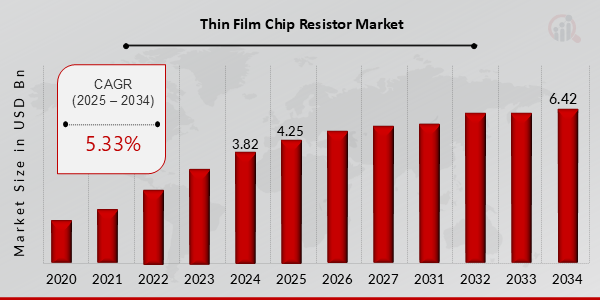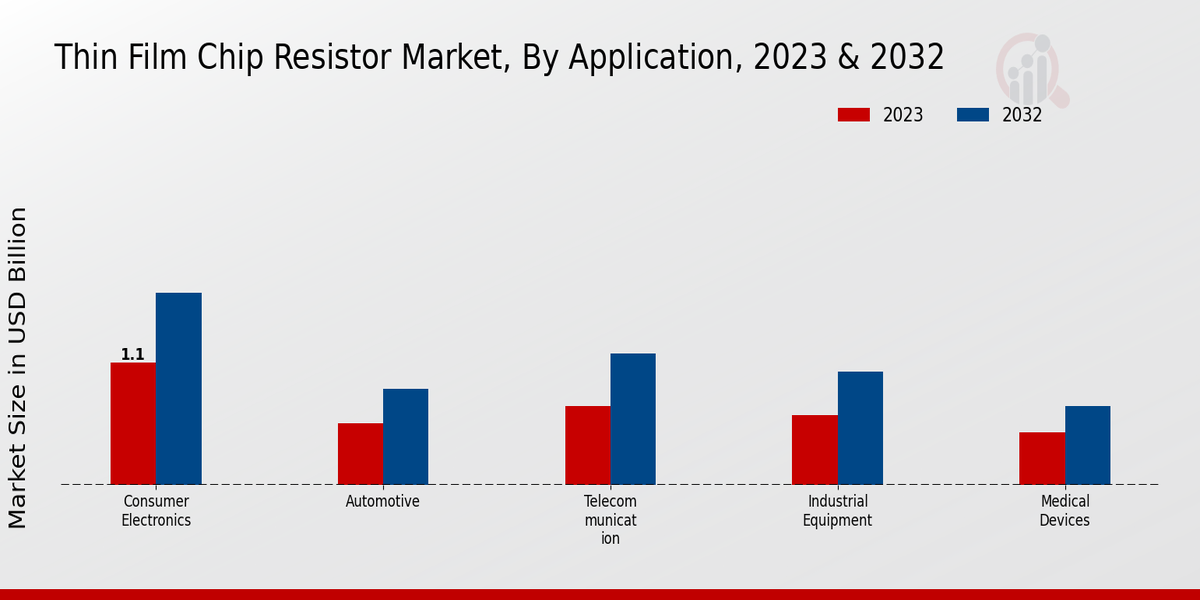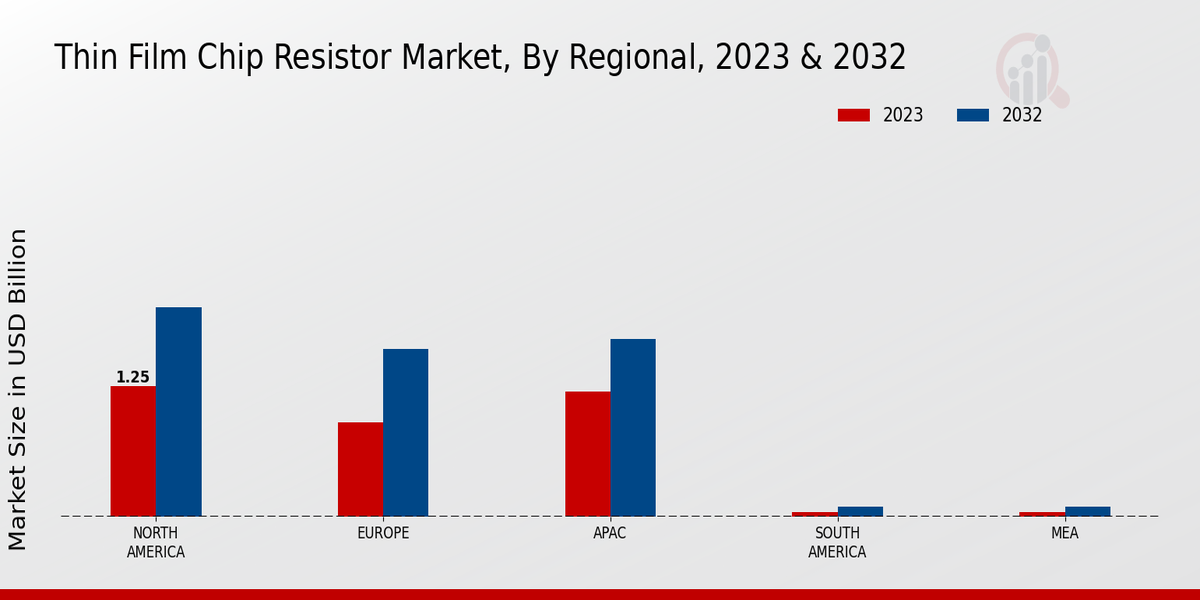Global Thin Film Chip Resistor Market Overview
Thin Film Chip Resistor Market Size was estimated at 3.82 (USD Billion) in 2024. The Thin Film Chip Resistor Market Industry is expected to grow from 4.25 (USD Billion) in 2025 to 6.42 (USD Billion) till 2034, exhibiting a compound annual growth rate (CAGR) of 5.33% during the forecast period (2025 - 2034).
Key Thin Film Chip Resistor Market Trends Highlighted
The Thin Film Chip Resistor Market is experiencing noteworthy growth driven by increasing demand for miniaturized electronic components across various sectors, including consumer electronics, automotive, and telecommunications. The rise in portable devices and advancements in smart technology are pushing manufacturers to innovate smaller and more efficient resistors. Additionally, the shift toward renewable energy systems and electric vehicles is creating a need for reliable and high-precision resistors, further encouraging market expansion. There are significant opportunities to be explored in the realm of Internet of Things (IoT) applications, where efficient power management is crucial.The integration of thin film chip resistors in new technology designed for smart homes and industrial automation can enhance performance and energy efficiency. As industries increasingly prioritize sustainability and energy-efficient solutions, the demand for high-quality resistors that support these advancements could lead to robust market growth. Recent trends indicate a shift towards more advanced materials and manufacturing processes to increase the durability and reliability of thin film chip resistors. The focus is on developing resistors with improved performance specifications, such as higher power rating and better temperature stability.Companies are also emphasizing the customization of resistors to meet specific industry needs. In addition, advancements in production techniques, such as automation and precision engineering, are expected to streamline manufacturing processes, which may reduce costs and increase scalability in the market. Overall, the thin film chip resistor market is positioned for substantial evolution and innovation in response to emerging technologies and market demands.

Source: Primary Research, Secondary Research, MRFR Database and Analyst Review
Thin Film Chip Resistor Market Drivers
Increasing Demand for Miniaturization in Electronic Devices
The trend towards miniaturization in electronic devices is one of the key drivers for the Thin Film Chip Resistor Market Industry. As consumer electronics continue to evolve, manufacturers are focused on developing smaller, more compact devices without compromising functionality. Thin film chip resistors, known for their small size and lightweight characteristics, are increasingly being adopted in various applications. This growing demand for smaller components is expected to foster innovation and enhance market growth.The integration of thin film chip resistors into high-density circuit designs is becoming more prevalent, leading to increased efficiency in electronic systems. Furthermore, industries such as telecommunications, automotive, and medical devices are pushing for even more compact and high-performance solutions. The rising popularity of wearable technology and IoT (Internet of Things) devices, which require miniaturized components, further emphasizes the necessity for high-quality thin film chip resistors.With advancements in manufacturing techniques, companies in the Thin Film Chip Resistor Market Industry are able to produce resistors that meet these miniaturization demands while maintaining high precision and reliability.
Growing Applications in Automotive Electronics
The increasing use of electronic components in the automotive sector significantly drives the Thin Film Chip Resistor Market Industry. As vehicles evolve into more technologically advanced machines, the demand for precise and reliable components becomes critical. Thin film chip resistors are utilized in various automotive applications, including power management systems, safety features, and advanced driver assistance systems (ADAS). The shift towards electric vehicles (EVs) also presents further opportunities for growth as these vehicles require specialized components for their control systems.Consequently, the automotive industry's shift towards electrification and automation is contributing to the burgeoning demand for thin film chip resistors.
Rising Demand in Telecommunications and Networking
The telecommunications sector is experiencing rapid growth due to the demand for advanced communication technologies. This has a direct impact on the Thin Film Chip Resistor Market Industry. With the expansion of 5G networks and the continuous enhancement of broadband infrastructures, the need for reliable and high-performance components is crucial. Thin film chip resistors play a vital role in ensuring signal integrity and reducing noise in telecommunications equipment.As consumers and businesses seek faster and more reliable connectivity, the demand for these resistors in networking applications is set to increase.
Thin Film Chip Resistor Market Segment Insights
Thin Film Chip Resistor Market Application Insights
The Thin Film Chip Resistor Market is witnessing substantial growth, driven by an increasing demand across various applications. In 2023, the market is valued at 3.45 USD Billion, with projected growth positioning it at 5.5 USD Billion by 2032. This robust expansion highlights the key trends within the Application segment, which includes various critical areas such as Consumer Electronics, Automotive, Telecommunication, Industrial Equipment, and Medical Devices. Among these applications, Consumer Electronics holds the majority share, valued at 1.098 USD Billion in 2023, reflecting the significant reliance on thin film chip resistors for devices such as smartphones, laptops, and smart home technologies. The Automotive application also plays a crucial role, valued at 0.549 USD Billion in 2023, driven by the integration of advanced electronics in vehicles for improved performance and safety features. Meanwhile, the Telecommunication sector, valued at 0.706 USD Billion, underlines the importance of reliable resistors in various communication technologies, including infrastructure for mobile networks and broadband services.Industrial Equipment ranks closely, valued at 0.627 USD Billion in 2023, showcasing the need for accurate and resilient components in manufacturing technologies and machinery. Lastly, the Medical Devices application accounts for 0.47 USD Billion, indicating a growing reliance on precision components in healthcare technologies. Each segment demonstrates growth potential, with the Consumer Electronics and Telecommunication sectors anticipated to lead the way, reflecting the increasing integration of smart technologies and connectivity. The market growth is further supported by key trends including advancements in technology, the miniaturization of components, and a push for higher efficiency in electronic devices. However, challenges such as rising raw material costs and the need for continual innovation remain present. Despite these challenges, opportunities for growth abound within the Thin Film Chip Resistor Market, particularly as applications expand into emerging markets and the Internet of Things (IoT) continues to proliferate across industries. In summary, the Application segment serves as a vital driver for the thin film chip resistor market, with each application contributing to the overall revenue in a significant manner.

Source: Primary Research, Secondary Research, MRFR Database and Analyst Review
Thin Film Chip Resistor Market Material Type Insights
The Thin Film Chip Resistor Market, valued at 3.45 USD Billion in 2023, encompasses various material types that cater to a wide array of applications. Within this segmentation, materials such as Silicon, Ceramic, Polymer, Glass, and Metal play crucial roles. Silicon, renowned for its excellent electrical properties, is widely utilized due to its cost-effectiveness and scalability. Ceramic materials are significant for their stability and temperature resistance, making them ideal for high-performance applications. Polymer is gaining traction, particularly in flexible electronics, while Glass offers superior durability and high thermal stability, catering to specialized industrial uses.Meanwhile, Metal resistors dominate with their excellent conductivity and are often employed in precision measurement applications. This diversity in materials contributes to the overall market growth, driven by increasing demand in electronics and automation sectors, while challenges such as sourcing and material costs provide opportunities for innovation and efficiency improvements across the industry. Insights into the Thin Film Chip Resistor Market data reflect a growing trend towards more efficient and reliable components across various applications, illustrating the strategic importance of material selection in enhancing product performance and sustainability.
Thin Film Chip Resistor Market Resistance Value Insights
The Thin Film Chip Resistor Market is expected to reach a valuation of 3.45 billion USD in 2023, with significant growth projected toward 2032. Within this market, the Resistance Value segment plays a critical role, being categorized into Low Resistance, Medium Resistance, and High Resistance. Low Resistance is particularly important, as it caters to applications requiring precision and reliability, dominating the market due to its widespread use in consumer electronics and automotive sectors. Medium Resistance follows closely, serving as a versatile option for various electronic devices, enhancing performance and stability in circuits.High Resistance, while catering to specialized applications, also sees growing demand, especially in telecommunications and aerospace industries, due to the unique requirements in these fields. Overall, trends such as increasing miniaturization of electronic components and the thriving demand for efficient energy solutions act as drivers for market growth. However, challenges remain in terms of fluctuating raw material prices and competition from alternative technology, creating both hurdles and opportunities within the evolving landscape of the Thin Film Chip Resistor Market.The segmentation of this market is vital for understanding how each component contributes to the overall revenue and growth patterns, highlighting the unique characteristics and demands of each type.
Thin Film Chip Resistor Market Form Factor Insights
The Thin Film Chip Resistor Market revenue for 2023 is valued at 3.45 billion USD, reflecting a continued demand for high-precision electronic components across various industries. Within this market, the Form Factor segment plays a crucial role in delivering superior performance and reliability through its various configurations. Among these, Chip Resistors have garnered significant attention due to their compact size, enabling space-saving designs in modern electronics. Likewise, Thin Film Resistors distinguish themselves by providing high accuracy and low noise, catering to applications where precision is paramount.Surface Mount Resistors dominate the market owing to their ease of manufacturing and compatibility with automated assembly processes. The increasing trend toward miniaturization of electronic devices and the growing demand for high-performance components are key factors driving the market growth. However, challenges such as raw material costs and competition from alternative technologies may affect market dynamics. Overall, the Thin Film Chip Resistor Market segmentation indicates a robust landscape with abundant opportunities for innovation and development in the Form Factor space, reinforcing its significance in the broader Thin Film Chip Resistor Market industry.
Thin Film Chip Resistor Market Regional Insights
The Thin Film Chip Resistor Market demonstrates promising growth across various regions, with a total valuation of 3.45 USD Billion in 2023, rising to 5.5 USD Billion by 2032. North America significantly holds the majority, with a valuation of 1.25 USD Billion in 2023, and expected to reach 2.0 USD Billion by 2032, driven by high demand in electronics and automotive sectors. Europe follows with a valuation of 0.9 USD Billion in 2023, anticipated to grow to 1.6 USD Billion by 2032, supported by advancements in telecommunications and industrial applications.The APAC region also plays a crucial role, valued at 1.2 USD Billion in 2023, and projected to reach 1.7 USD Billion by 2032, benefiting from rapid industrialization and increasing consumer electronics manufacturing. South America and MEA are relatively smaller markets, each valued at 0.05 USD Billion in 2023, expected to double to 0.1 USD Billion by 2032, as they gradually adopt electronic technologies. The market trends indicate that North America's dominance stems from its innovative landscape, while APAC’s growth is fueled by substantial manufacturing capabilities.

Source: Primary Research, Secondary Research, MRFR Database and Analyst Review
Thin Film Chip Resistor Market Key Players and Competitive Insights
The competitive landscape of the Thin Film Chip Resistor Market is characterized by a diverse array of players vying for market share through innovative product offerings and strategic partnerships. This sector has experienced significant growth due to the increasing demand for electronic devices that require precise resistance values, resulting in a steady influx of technological advancements. Companies are focusing on enhancing their product quality, which has emerged as a critical success factor in this market. Furthermore, the trend towards miniaturization in electronics has prompted manufacturers to invest in research and development to deliver thin film chip resistors with superior performance characteristics, ultimately driving competition and enriching consumer choices. Additionally, market players are also exploring various distribution channels and expanding their geographic footprints to cater to the growing global demand for these components.Vishay Intertechnology is a leading entity within the Thin Film Chip Resistor Market, known for its robust presence and extensive product portfolio that caters to various sectors including telecommunications, automotive, and industrial applications. The company boasts a strong reputation for producing high-precision thin film resistors that are widely recognized for their reliability and stability, making them a preferred choice among manufacturers. Vishay Intertechnology's commitment to quality is evident in its adherence to stringent industry standards and the utilization of cutting-edge technologies in its production processes. Furthermore, the company benefits from a well-established distribution network, which facilitates timely delivery and enhances customer satisfaction. The focus on innovation and customer-centric solutions has enabled Vishay Intertechnology to solidify its position in the competitive landscape, appealing to both existing and prospective clients.Bourns has made significant strides in the Thin Film Chip Resistor Market through its dedication to manufacturing durable and high-performance resistive components. The company’s focus on advancing thin film technology sets it apart, as it continually enhances its product offerings to meet the evolving demands of the electronics industry. Bourns not only emphasizes the importance of quality assurance in its manufacturing processes but also invests in sustainable practices to ensure environmental responsibility, aligning with global trends toward sustainability in electronics production. Their thin film chip resistors are designed to provide accurate performance in a compact footprint, which appeals particularly to industries focused on miniaturization. Bourns’ strategy of maintaining close relationships with customers through tailored solutions and responsive service enhances its competitiveness, positioning it favorably in the ever-growing market for advanced resistive solutions.
Key Companies in the Thin Film Chip Resistor Market Include
- Vishay Intertechnology
- Bourns
- Ohmcraft
- Susumu
- Vishay Dale
- Rohm Semiconductor
- Caddock Electronics
- Falco
- TT Electronics
- AB Elektronik
- KOA Speer Electronics
- Yageo Corporation
- Walsin Technology
- NTE Electronics
- Panasonic Corporation
Thin Film Chip Resistor Industry Developments
The Thin Film Chip Resistor Market has witnessed notable developments recently, particularly in terms of market valuation growth among key players. Companies such as Vishay Intertechnology and Bourns have reported an upsurge in demand due to the expanding electronics sector, thereby impacting their financial performance positively. Ohmcraft and Susumu are also gaining traction, driven by the surge in applications in high-frequency and precision electronics. In the merger and acquisition landscape, there have been no significant announcements involving the companies of focus such as Rohm Semiconductor, Caddock Electronics, or TT Electronics, indicating a period of stability. On the expansion front, both Yageo Corporation and KOA Speer Electronics are enhancing their production capabilities to meet rising global demand, reflecting a competitive market environment. Additionally, Panasonic Corporation has been actively innovating in resistor technologies, further solidifying its position in the market. Overall, the growth trend is significantly influenced by advancements in technology and increasing electronic applications, positioning the Thin Film Chip Resistor Market for continued expansion.
Thin Film Chip Resistor Market Segmentation Insights
Thin Film Chip Resistor Market Application Outlook
- Consumer Electronics
- Automotive
- Telecommunication
- Industrial Equipment
- Medical Devices
Thin Film Chip Resistor Market Material Type Outlook
- Silicon
- Ceramic
- Polymer
- Glass
- Metal
Thin Film Chip Resistor Market Resistance Value Outlook
- Low Resistance
- Medium Resistance
- High Resistance
Thin Film Chip Resistor Market Form Factor Outlook
- Chip Resistors
- Thin Film Resistors
- Surface Mount Resistors
Thin Film Chip Resistor Market Regional Outlook
- North America
- Europe
- South America
- Asia Pacific
- Middle East and Africa
| Report Attribute/Metric |
Details |
|
Market Size 2024
|
USD 3.82 Billion
|
|
Market Size 2025
|
USD 4.25 Billion
|
|
Market Size 2034
|
USD 6.42 Billion
|
|
Compound Annual Growth Rate (CAGR)
|
5.33% (2025-2034)
|
| Report Coverage |
Revenue Forecast, Competitive Landscape, Growth Factors, and Trends |
|
Base Year
|
2024
|
|
Market Forecast Period
|
2025-2034
|
|
Historical Data
|
2020-2023
|
| Market Forecast Units |
USD Billion |
| Key Companies Profiled |
Vishay Intertechnology, Bourns, Ohmcraft, Susumu, Vishay Dale, Rohm Semiconductor, Caddock Electronics, Falco, TT Electronics, AB Elektronik, KOA Speer Electronics, Yageo Corporation, Walsin Technology, NTE Electronics, Panasonic Corporation |
| Segments Covered |
Application, Material Type, Resistance Value, Form Factor, Regional |
| Key Market Opportunities |
Rising demand in consumer electronics, Growth in automotive applications, Advancements in connectivity technologies, Increased focus on miniaturization, Expanding applications in renewable energy |
| Key Market Dynamics |
Increasing demand for miniaturization, Growing applications in electronics, Technological advancements in fabrication, Competitive pricing and cost pressures, Expanding automotive electronics sector |
| Countries Covered |
North America, Europe, APAC, South America, MEA |
Frequently Asked Questions (FAQ) :
The Thin Film Chip Resistor Market is expected to be valued at 6.42 USD Billion in 2034.
The market is anticipated to exhibit a CAGR of 5.33% during the forecast period from 2025 to 2034.
North America is projected to dominate the market with a value of 2.0 USD Billion by 2032.
The Consumer Electronics application segment is expected to reach 1.729 USD Billion in 2032.
Major players include Vishay Intertechnology, Bourns, Ohmcraft, Susumu, and Rohm Semiconductor.
The Telecommunication application is expected to grow to 1.179 USD Billion by 2032.
The Automotive application is projected to be valued at 0.864 USD Billion in 2032.
The Industrial Equipment segment is expected to reach 1.021 USD Billion by 2032.
The Medical Devices application segment is expected to grow to 0.707 USD Billion by 2032.
The APAC region is projected to be valued at 1.7 USD Billion by 2032.

















